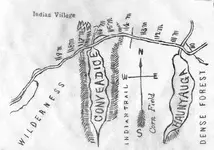Gypsy Heart
Gold Member
- #1
Thread Owner
Hemlock NY ............General Sullivan's Gold
Persistent of the sparsely settled hills is the belief in buried treasure, hidden it is alleged, by General Sullivan's officers, while crossing the narrow ridge northwest of the lake as a precautionary measure against being captured by the Indians. Sporadic fits of digging extended over a period of a century and a half have yeilded nothing, however, in the way of silver and gold.
Pioneer settler of the Hemlock area was Phillip Short who came in 1790. There followed a steady migration from New England to this lush country of the Genesee as all of western New York was originally termed. Settlers located at first at the foot of the lake and along the outlet. Saw mills went up and from the immense lumber output grew Hemlock's soubriquet, "Slab City."
The first grist mill in the area was built in 1795 on the site of the present Beam mill. Stones for these crude mills were brought, it is claimed, by sailing vessels from France free of charge as ballast to the ships. The Sullivan marker which stands near the foot of the lake was formed partly from these original millstones as a means of preservation.
http://www.wemett.net/hemlock/whats_in_a_name.html
Persistent of the sparsely settled hills is the belief in buried treasure, hidden it is alleged, by General Sullivan's officers, while crossing the narrow ridge northwest of the lake as a precautionary measure against being captured by the Indians. Sporadic fits of digging extended over a period of a century and a half have yeilded nothing, however, in the way of silver and gold.
Pioneer settler of the Hemlock area was Phillip Short who came in 1790. There followed a steady migration from New England to this lush country of the Genesee as all of western New York was originally termed. Settlers located at first at the foot of the lake and along the outlet. Saw mills went up and from the immense lumber output grew Hemlock's soubriquet, "Slab City."
The first grist mill in the area was built in 1795 on the site of the present Beam mill. Stones for these crude mills were brought, it is claimed, by sailing vessels from France free of charge as ballast to the ships. The Sullivan marker which stands near the foot of the lake was formed partly from these original millstones as a means of preservation.
http://www.wemett.net/hemlock/whats_in_a_name.html







